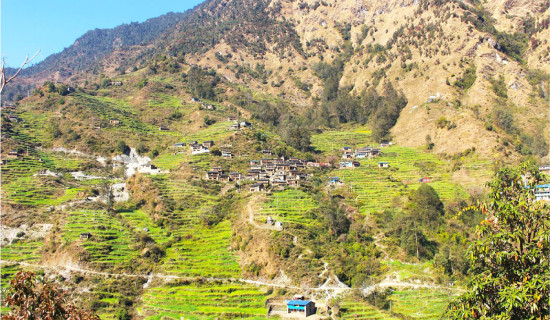- Friday, 9 January 2026
Wetlands Are Not Wastelands
Nepal is rich in wetlands. According to the National Wetland Policy 2012, wetlands are water bodies originating from underground sources of water or rainfall. They are swampy areas with flowing or stagnant water - fresh, brackish or salt. They may be natural or artificial and permanent or temporary. Wetlands are in the form of marshy lands, riverine floodplains, lakes, ponds, water storage areas, farmlands or tidal flats. In Nepal, wetlands are categorised as rivers, lakes, ponds, reservoirs, marshy lands and irrigated paddy fields. The country has 242 wetlands, which range from the Himalayan region through the hilly region to the Terai belt. There are 19 types of natural and 10 types of artificial wetlands in the country. The wetlands cover 819,277 hectares of the total land.
The Convention on Wetlands, popularly called the Ramsar Convention, was adopted in Ramsar, Iran in 1971. As per the Convention, wetlands are areas of marsh, fen, peatlands and water, natural or artificial, permanent or temporary, where the water is static or flowing, fresh, briny or salty, including areas of water logging made by man like paddy fields, the depth of which at low tides does not exceed six metres.
Ecological considerations.
The Convention aims at conserving wetlands across the world for ecological and other considerations. Oldest among the modern global intergovernmental environmental agreements, the Convention provides a framework for national action and international cooperation for the conservation of wetlands and for the prudent use of resources generated by wetlands. Nepal signed the Ramsar Convention in 1988.
There are 171 countries as contracting parties to the Convention and there are 2,394 wetlands designated as Ramsar Sites. These wetlands of international importance cover 253,900,552 hectares in area. Nepal boasts ten Ramsar sites covering 60,651 hectares. They are Phoksunde Wetland (Shey Phoksunde National Park), Koshi Tappu Wildlife Reserve, Jagadishpur Reservoir, Gosaikunda Wetland, Gokyo Wetland Series, Ghodaghodi Lake Area, Beeshazar and Associated Lakes, Mai Pokhari, Rara Lake and Lake Cluster of Pokhara (a cluster of nine lakes).
Wetlands have ecological, cultural, religious, recreational and touristic significance. They serve as a habitat for many species of flora and fauna. They also abound in many threatened and endangered species. They are also important for migratory birds, aquatic animals and wild animals. Some birds migrate to Nepal from as far away as Cyprus and Siberia. The wetlands are home to 230 indigenous species of fish, 102 species of phytoplankton, 109 species of molluscs and 117 species of amphibians. Likewise, the wetlands shelter 27 per cent of nationally threatened species of birds, 85 per cent of indigenous vertebrates and 24 per cent of nationally protected plants.
The wetlands are ideal places for tourists – both domestic and foreign. Nature lovers prefer to visit the wetlands, where they can enjoy themselves in a tranquil environment. By managing the wetlands properly, the flow of tourists to them can be increased. In a cash-strapped country like ours, additional income from the tourism industry can be generated. This will further support tourism entrepreneurs and generate employment opportunities benefitting local communities.
Wetlands have various benefits to offer to both man and the environment. They regulate water and water supply, purify stagnant water, recharge groundwater, control soil erosion and floods, play a role in waste management, act as an atmospheric, biological and climate regulator and contribute to soil formation, nutrient recycling or retention and pollination. They also support the food web system and are also sources of genetic resources. They can also sustain biodiversity and agro-biodiversity. Furthermore, most rural communities in Nepal depend on wetlands for their livelihoods. Majhi Jalari, Tharu and Mallah communities, for example, are dependent on the wetlands. Fishing, hunting and irrigation are some of the benefits wetlands provide for such communities.
In recent times, the wetlands are facing a threat to their existence. Haphazard hunting, growing urbanisation, expansion of human settlements, encroachment, drainage for agricultural purposes and the like are factors that are degrading the wetlands in Nepal. Development works are also responsible for the degradation of the wetlands. Development has both good and bad aspects. But development works should be carried out taking environmental factors into consideration. It is reported that 5.41 per cent of the wetlands have been converted into croplands. Introduction of exotic species of plants, siltation and haphazard use of wetland resources are the other reasons for the degradation of the wetlands.
Participatory approach
The Wetland Policy of Nepal is designed to conserve wetlands scattered throughout the country by enlisting the participation of local communities. The Policy also accentuates the judicious use of wetland resources. From ecological and other viewpoints, the conservation of wetlands is of paramount importance. The wetlands can be better conserved if the local communities are directly involved in it. For this, the capacity of such communities need to be enhanced. A participatory approach to the conservation of wetlands is needed.
Moreover, the government should embark upon an awareness campaign on the conservation of wetlands as well as on the sustainable use of wetland resources. The government should also document the wetlands scattered throughout the country. Such records will enable policymakers to draw up appropriate strategies for the conservation of the wetlands. Weak laws may be responsible for the wetlands being encroached upon. So the government should frame strong laws so as to discourage or prevent encroachment on the wetlands. After all, wetlands are not wastelands. It is our duty to conserve them for our posterity. So the government, local communities and other stakeholders should act in tandem to conserve the wetlands for ecological and other benefits.
(Maharjan has been regularly writing on contemporary issues for this daily since 2000.)

















